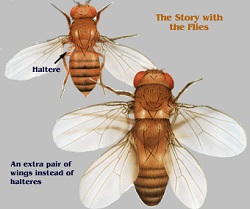TRANSLATE THIS ARTICLE
Integral World: Exploring Theories of Everything
An independent forum for a critical discussion of the integral philosophy of Ken Wilber
 Rupert Sheldrake Rupert Sheldrake, PhD, is a biologist and author of more than 80 scientific papers and 11 books, the most recent being Science Set Free (called The Science Delusion in the UK). He was a Fellow of Clare College, Cambridge University, and a Research Fellow of the Royal Society. His website is www.sheldrake.org. This is a response to my essay on Rupert Sheldrake and the Evo-Devo Revolution. Morphogenetic
Fields
Reply to Frank Visser
Rupert Sheldrake
Carroll and I agree in seeing morphogenetic fields, or developmental modules, as playing a major role in evolution.
I read Frank Visser's essay “Rupert Sheldrake and the Evo-Devo Revolution” with much interest. I agree with him that evolutionary developmental biology is a major step forward and, like him, I'm fascinated by the discoveries that researchers in this field have made. I discuss them in the 3rd edition of A New Science of Life (2009; Icon Books, London; published in the United States under the title Morphic Resonance, Inner Traditions Int., Rochester, VT) and also in the 2nd edition of The Presence of the Past (2011; Icon Books, London; Inner Traditions Int., Rochester, VT).
Contrary to the impression that Visser creates, morphogenetic fields are a central concept in evolutionary developmental biology, or evo-devo for short. One of the central features of developmental biology is that development is modular. Particular structures, like limbs, or eyes or antennae, either appear or they do not. With special kinds of genetic mutation, called homeotic mutations, an entire modular structure can be switched on or switched off, or interchanged with another. For example in bithorax mutants of fruit flies, the halteres (small balancing organs on the segment behind the wings) are replaced by an extra pair of wings.
These modular patterns of development have been interpreted since the 1920s in terms of morphogenetic fields, and evo-devo biology has led to a resurgence of the morphogenetic field concept. In a paper co-written by Sean B. Carroll, to whose work Visser refers, the authors write,
“The concept of the morphogenetic field, a discrete set of cells in the embryo that gives rise to a particular structure, has held great importance in experimental embryology. The discovery of genes whose products control the formation and identity of various fields, dubbed 'selector genes', has enabled the recognition and redefinition of fields as discrete territories of selector gene activity.” (Guss et al., 2001, Control of a Genetic Regulatory
Network by a Selector Gene, Science 292, 1164-6, PDF)
The genes involved in homeotic mutations play a key role as switches in development. But the biggest surprise in evo-devo biology was that key switch genes, often called homeobox genes, or hox genes for short, are almost identical in organisms as different as fruit flies, mice and humans. Although hox genes play a role in the determination of the body plan, they cannot themselves explain the shape of the organisms. Since these genes are so similar in fruit flies and in us, they cannot explain the differences between flies and humans.
It was shocking to find that the diversity of body plans across so many different animal groups was not reflected in diversity at the level of the genes. As two leading developmental biologists commented, “Where we most expect to find variation, we find conservation, a lack of change”. (Gerhart, John; Kirschner, Marc (1997). Cells, Embryos and Evolution. Blackwell Science)
Evo-devo biologists and I myself use the term morphogenetic field to describe modular developmental systems, but our interpretations of how these fields work are very different. As Visser points out, Carroll hopes to explain the different modules of development through regulatory genes that somehow generate the different forms of the organs in fruit flies, mice and humans through genetic switches that are embedded in the “dark matter of the genome.” Hereafter, Carroll's explanation soon dissolves into hand waving about complex interactions not yet fully understood. In his own words, “chains of parallel and successive operations that build complexity” will eventually explain the diversity of forms (Carroll, S.B. 2005. Endless Forms Most Beautiful, Quercus Books, London, p. 106)
This is the same kind of promissory materialism that developmental biologists have been coming up with for decades.
This is the same kind of promissory materialism that developmental biologists have been coming up with for decades. Even in principle, it cannot give a satisfactory explanation for the development of form. Regulatory genes by definition regulate other genes, and hence regulate the formation of proteins. That's what coding genes do: they code for the sequence of amino acids in protein molecules. They do not code for the shape of a wing, or an eye, or a leg. They just enable organisms to make particular proteins. So even if the dark matter of the DNA contains complex regulatory sequences, all they will enable the developing organism to do is to make particular proteins in particular sequences. The development of form itself, morphogenesis, is still unexplained. It's like trying to explain the construction of a computer by saying that the production of components, like transistors, results in complex chains of operations that cause the computer to assemble itself, and then start functioning spontaneously.
By contrast, my hypothesis of morphogenetic fields sees them as active fields of information that shape developing organisms. These fields inherit their own forms by the process of morphic resonance from past organisms.
Visser quotes a TV documentary in which the narrator said, “As a solution to the mystery of how evolution works, genes and their mutations were only part of the story. There had to be something else, more subtle and more mysterious going on”. Visser dismisses the possibility that this “something else” depends on form-shaping morphogenetic fields, and instead hopes that “further fascinating discoveries” in evo-devo biology will provide the answers. This is an act of faith.
Like Sean B. Carroll, Visser is dismissive of alternative hypotheses, including my own. But Carroll's confidence in the face of so much uncertainty arises not from the scientific facts, but from a philosophical or ideological belief system. Carroll is a fellow of a militant sceptical organisation, the Committee for Skeptical Inquiry, publishers of the Skeptical Inquirer, and is deeply committed to a materialist worldview. I do not know whether Visser shares this commitment or not, but he has allowed himself to be carried along by Carroll's deeply held beliefs.

Carroll and I agree in seeing morphogenetic fields, or developmental modules, as playing a major role in evolution. Homeotic mutations can cause one module to be supplanted by another, or a module to be suppressed or duplicated, and hence lead to changes in form, as in bithorax fruit flies with four wings instead of two. I see these switch genes as affecting the tuning system, causing an nascent embryonic structure to tune into one morphogenetic field rather than another, rather like a mutation in the tuning circuit of a TV receiver causing it to tune into a different TV channel. But changing, suppressing or duplicating existing modules does not account for their appearance in the first place, just as tuning into one TV channel rather than another does not explain the content of the channels themselves. We can speculate about the creative leaps that gave rise to new structures – the first eye, or the first feather, or the first flower, for example – but we cannot study them in the same way as we can study the repetitive, modular development that enables animals and plants to take up their characteristic forms generation after generation.
We still understand very little about the development of form in animals and plants.
We still understand very little about the development of form in animals and plants. The dogmatism of materialists may create an illusion of understanding, or at least reinforce the faith that a mechanistic explanation is only a few years, or decades, away. But it is scientifically healthier to admit that many of the fundamental questions about the forms of animals and plants and their inheritance are open. Carroll and Visser would do well to take Visser's own advice, and “pay closer attention to what science can actually do and has accomplished.”
|
 Rupert Sheldrake, PhD, is a biologist and author of more than 80 scientific papers and 11 books, the most recent being Science Set Free (called The Science Delusion in the UK). He was a Fellow of Clare College, Cambridge University, and a Research Fellow of the Royal Society. His website is www.sheldrake.org. This is a response to my essay on Rupert Sheldrake and the Evo-Devo Revolution.
Rupert Sheldrake, PhD, is a biologist and author of more than 80 scientific papers and 11 books, the most recent being Science Set Free (called The Science Delusion in the UK). He was a Fellow of Clare College, Cambridge University, and a Research Fellow of the Royal Society. His website is www.sheldrake.org. This is a response to my essay on Rupert Sheldrake and the Evo-Devo Revolution.
